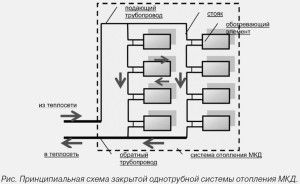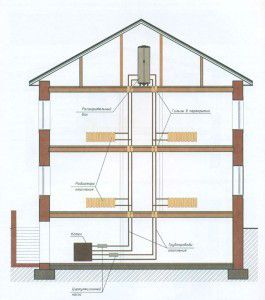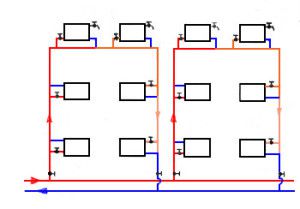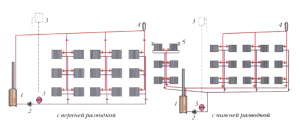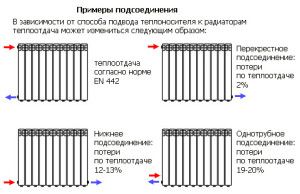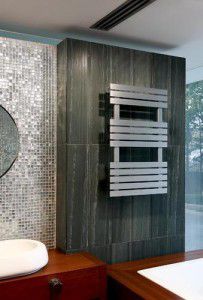How to choose the optimal scheme for heating? One of the determining parameters is the minimum length of pipelines. In many cases, horizontal wiring is done for this. However, there are non-standard layouts of a house or apartment for which a vertical heating system is best applicable: wiring, radiators, batteries must be designed and selected according to special conditions.
Features of the vertical layout
How does a vertical one-pipe heating system differ from a similar horizontal? First of all, with minimal heat loss. This is ensured by the location of the supply lines. In contrast to a horizontal pipe, the vertical system performs the function of thermal risers.
In fact, the vertical layout of heating in the original version is very rare. This is due to the peculiarity of the installation and distribution of the coolant throughout the system. A similar scheme was popular in the design of houses "Khrushchev". Due to the small area of the apartments, it was not practical to establish a horizontal pipe layout. Therefore, they developed a vertical scheme for supplying hot water. It has the following features:
- Several thermal risers to which batteries are connected. In most cases, it was a single pipe heating system;
- The ability to adjust the temperature of the radiator. This is a consequence of the features of the system;
- The coolant flow into the rooms was carried out along separate circuits.
As can be seen from the above, the vertical wiring of the heating system has a number of significant drawbacks. That is why it is practically not used for private houses, as well as in modern multi-story residential construction.
In some cases, a combined scheme is applicable when the distribution riser is made horizontal, separate lines for connecting radiators to the system are already diverging from it. Therefore, you need to find out whether it is advisable to use a vertical heating distribution for a private house.
For this scheme, it is recommended to choose vertical wall-mounted heating radiators. Despite their high cost, they are best suited for such a system.
Relevance for autonomous heating
The first problems may arise at the stage of connecting the batteries. This is due to the location of the nozzles and the design of the heating device itself. Almost all models are designed for installation in a horizontal system. Therefore, experts recommend installing special vertical wall-mounted heating radiators.
However, one should take into account the features of their functioning. The lower the battery, the more efficient it will work. Cold air has a greater mass than warm, so it concentrates on the floor. The task of the battery is to heat it. Therefore, it should be located as low as possible. Narrow vertical radiators are structurally unable to fully perform this task.
But this is not the only drawback characteristic of vertical wiring of the heating system. It can be solved by slightly increasing the length of the radiator inlet pipes. If you adhere to the canons of the scheme, another problem will arise. It consists in tying vertical tubular heating radiators to the location of the heat risers. For rooms with a small quadrature, this is not significant.However, if the room has an area of 40 m2 or more and at the same time 2 external walls, it will be necessary to install several thermal risers.
Summing up, we can distinguish the following conditions when the installation of a vertical single-pipe heating system makes sense:
- A relatively large number of floors. Usually from 5 or more;
- The relatively small area of the rooms;
- Good thermal insulation and even heat distribution throughout the room.
Alas, for most private cottage houses, these characteristics are not typical. That is why they prefer to install a horizontal heating system as one of the best ways to maintain a comfortable temperature.
In older apartment buildings with a two-pipe vertical heating system with a lower wiring, a meter must be installed on each riser to account for heat. They can be from 2 to 5.
Single pipe or double pipe system
It is important to decide for which circuit vertical water heating batteries will work best. At first glance, it seems that a traditional two-pipe heating system with its advantages is optimal for vertical wiring. This can only be ascertained after analyzing the operational and technical characteristics of each circuit.
Single pipe heating system
In it, the coolant circulates in a closed loop, and the radiators are connected in series, i.e. the degree of heating of water in the last battery will be significantly lower than in the first. For a horizontal system, this would be very important. But since the length of the heat circuit is small, the level of temperature of the coolant in the vertical water heating batteries will be relatively the same. As an additional control measure, bypasses can be installed between the inlet and outlet pipes of each radiator.
Other features of a single pipe vertical wiring of the heating system are as follows:
- The minimum amount of consumables for installing the pipeline;
- The ability to make a gravity system without installing a circulation pump;
- Optimum coolant volume. This parameter can be adjusted by selecting pipes of larger or smaller diameters.
Given these factors, a vertical one-pipe heating system was chosen as optimal for multi-storey buildings built in 60-80. last century.
Two pipe heating system
For this system, installation of two trunk circuits is required. One of them receives hot coolant, and the second acts as a return pipe.
At the same time, they should be located next to each other, since the connection of vertical steel heating radiators occurs in parallel. As a result, the volume of required water increases significantly, which affects the hydrodynamic resistance of the system. Often, two-pipe wiring for vertical heating is done with a forced supply of coolant. For this, powerful circulation pumps are installed, as well as controls - expansion diaphragm tanks, air vents.
In practice, a two-pipe vertical heating system with a lower wiring is extremely rare. This is due to the complexity of installation, specific operational characteristics. Experts highlight one significant advantage of such a scheme - the low likelihood of air congestion.
Combined heating distribution with horizontal flow of coolant along vertical risers will be optimal for a 2 or 3-story building with a large area. In this way, the appearance of air jams in the system can be minimized.
The choice of radiator for vertical wiring
For the above systems, it is difficult to find vertical water heating batteries.This is due to limited ways to connect them to the circuit. The greatest heat transfer of the radiator will be with one-sided upper and lower arrangement of the pipes.
In most cases, vertical tubular heating radiators are characterized by the location of the mounting units on one side. From the point of view of the distribution of hot water over the entire volume of the structure, a detailed scheme is considered the most effective.
Accuro-korle
Currently, it is one of the most famous manufacturers of wall-mounted vertical radiators. A feature of his models is the predominance of Hi-Tech style. A striking example of such a design solution is the Caftan range of radiators. They can perform not only the functions of a heating device, but also a heated towel rail. Currently, the average cost of Caftan is from 30 to 43 thousand rubles.
The Escape model is a typical tubular vertical water heater. The strict classical form will make it possible to fit the radiator into almost any interior of the bathroom or hallway. Its cost is slightly lower than that of Caftan - from 23 to 34 thousand rubles. with the same technical specifications.
In addition to this well-known manufacturer, there are several reliable suppliers of such radiators - Caftan (Turkey), Kermi (Germany), Jaga (Belgium). Alas, the economic segment of the vertical battery market does not exist as such. The only way out is to make a similar design yourself. But its technical characteristics will be significantly lower than that of factory models. This is another factor in the unpopularity of the vertical wiring of the heating system.
Should I prefer a vertical heating system? Wiring, radiators, batteries for it will cost a lot, and installation has a number of significant drawbacks. The main thing is to find out for yourself the feasibility of installing it. It can be used for a small apartment building with independent heating. But first you need to do all the required calculations.
The video shows an example of a vertical two-pipe heating system in an office building:
